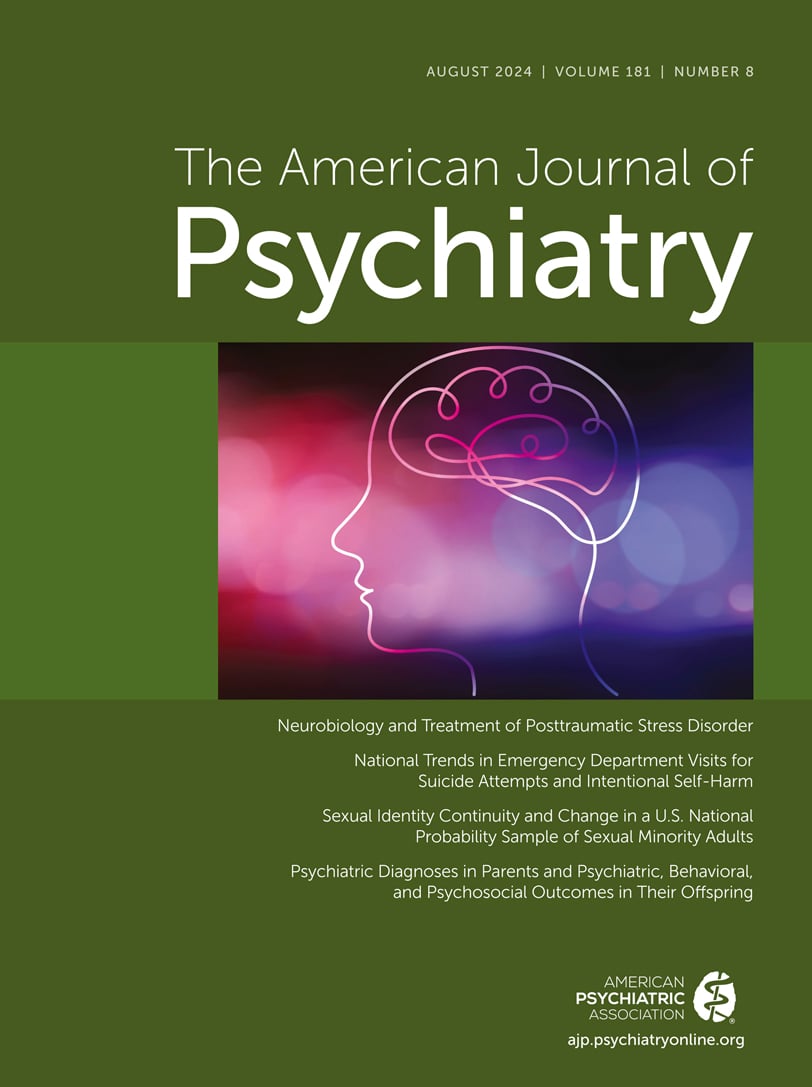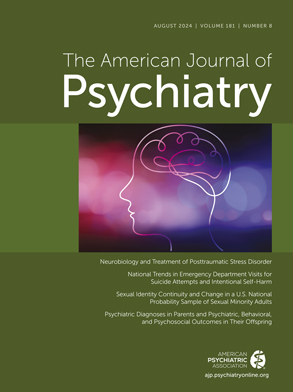The minority stress model has been the dominant model underlying much of the surge in sexual and gender minority health research over the last 20 years. This model provides a framework to acknowledge and increase our understanding of health disparities found among sexual and gender minority populations and has been applied particularly to understanding disparities in mental health. Following Evelyn Hooker’s research that helped depathologize homosexuality (
1) and contributed to the eventual removal of homosexuality as a diagnosis in DSM in 1973, it became challenging to map the mental health concerns of sexual minorities out of fear of repathologizing their identities and experiences. This situation changed with Ilan Meyer’s seminal paper (
2), which provided a framework to understand the impact of stigma and discrimination on the mental health of sexual minorities. Subsequently, the minority stress model was extended to understand the mental health challenges of gender minorities (
3,
4). The emphasis on social determinants of health was pivotal, showing that stigma attached to sexual and gender nonconformity is associated with psychological distress, a relationship that is moderated by coping and social support. Minority stressors range from the distal (prejudice events, discrimination, and violence) to the proximal (expectations of rejection, concealment, and internalized homo-, bi-, and transphobia). Research has shown the importance of this distinction in that proximal factors may be particularly important to predict mental health concerns such as nonsuicidal self-injury (
5,
6) and sleep health (
7). However, in all the research that the minority stress model generated, the role of identity has received relatively little attention. Although Meyer’s model (
2) includes minority identity characteristics of prominence (of lesbian, gay, bisexual, transgender, queer+ [LGBTQ+] identity in the person’s sense of self), valence (tied to self-validation), and integration (of LGBTQ+ identity with the person’s other identities), few studies have focused on these aspects of the model (
8). Particularly, the development of identity and resilience over time, across the lifespan, remains understudied.
The article by Krueger and colleagues in this issue of the
Journal (
9) is an example of research to fill this gap. The authors used data from the Generations study, which is another achievement of Dr. Meyer—the first national probability sample of the U.S. sexual minority population, established in a unique partnership with Gallup (
10). Krueger and colleagues break with the larger tradition, stemming from HIV research, of using sexual behavior as the primary criterion to define a sexual minority sample (men who have sex with men, bisexually active women, etc.); instead, they lead with self-identification as the operationalization of sexual minority status. And they used longitudinal data, which are sorely needed to further advance our understanding of LGBTQ+ health (
11). Although the vast majority of the 683 participants in their sample did not markedly change their sexual orientation identity over the 2 years of the study, 9% did change from monosexual (lesbian, gay, or same-gender loving) to plurisexual (bisexual, queer, or pansexual) or vice versa. The authors then explored associations of these changes with measures of mental health and substance use and found that, for both female and male participants, changes in sexual orientation identity were associated with problematic alcohol use. In addition, female participants who changed their self-identification reported lower social well-being and marginally higher psychological distress, and male participants who changed their sexual orientation identity reported more problematic drug use. The authors found some other interesting sex differences. For female participants, a change from a monosexual to a plurisexual identity was more stressful, whereas for male participants, a change from a plurisexual to a monosexual identity was more stressful. Moreover, among female participants, a plurisexual identification was associated with more days of poor mental health than a monosexual identification, and among male participants, a plurisexual identification was associated with less problematic alcohol use than a monosexual identification. The authors attributed these associations to the impact of social stigma as well as changes in the social environment contributing to added stress and harmful coping behaviors.
The findings from this study are consistent with previous research that showed poorer mental health and well-being among plurisexual women. For example, in a longitudinal study of sexual minority women, bisexual and “mostly heterosexual” women were most likely to report hazardous drinking and depression (
12). These findings are typically attributed to the lack of available group-level coping for plurisexual individuals (i.e., a community of gay and lesbian people is more developed and more readily available than a community of bisexual people). However, Krueger and colleagues’ finding that a change from plurisexual to monosexual self-identification among male participants was associated with more days of poor mental health and lower social well-being is surprising. Although the authors hint at the potential role of identity development in explaining the latter findings and recommend further research in this area (particularly for men), what has been sorely lacking in empirical research on the health and well-being of sexual and gender minorities is a focus on identity and psychosocial development across the lifespan.
In addition to social and environmental factors so well explicated in the minority stress model, there may be other reasons why changes in sexual or gender identity across the lifespan may be associated with psychological distress, poorer mental health, and decreased well-being. First and most generally, for many people, change is stressful. Among trans and nonbinary people, struggling with one’s gender identity was found to be associated with mental health concerns independent of social stigma (
5). Second, without stress, there might be no growth. Thus, for psychosocial development, including sexual and gender identity development, an optimal level of stress may be a necessary catalyst for growth. This possibility does not mean that Krueger and colleagues’ conclusion that a change in identity may be accompanied by increased vulnerability to poorer mental health and well-being is not correct; however, situating these findings in the context of psychosocial and identity development helps to normalize the experience for sexual and gender minority individuals going through these changes. Mental health professionals are encouraged to consider a developmental frame when LGBTQ+ patients in distress reach out to them for assistance and to evaluate and discuss the patient’s concerns in light of the patient’s life story. We are living in a time of great emphasis on evidence-based cognitive-behavioral approaches to care. These strategies are tremendously useful in alleviating symptomatology. However, a strictly cognitive-behavioral approach may neglect processes of human development, providing little room to ponder more existential questions of “Who am I in relationship to others and the world? Why am I here at this particular time in history? Where am I going? What is the meaning of the current difficulties that I am experiencing?”
Well-established, but often criticized, models outlining the developmental tasks of the LGBTQ+ coming out process can be helpful here (
13,
14). These models describe stages of an early awareness of being different, through community affiliation and intimate relationships, to integration. Critiques of these models include their Eurocentric bias. The models arose from the authors’ clinical experience in working with predominantly White patients from European descent and lacked adequate attention to the influence of intersectional and structural oppressions. We indeed need theory development and research that accounts for greater diversity and the challenges and resiliencies of individuals with multiple stigmatized identities (e.g., Latina lesbian women and Black trans men). Another critique of these models is that they rely on linear stages of development (
15), despite the disclaimer by the models’ authors that developmental tasks across the lifespan do not necessarily proceed in a linear fashion and may include a cyclical developmental pattern, in which earlier stages are revisited as life progresses and new challenges present themselves. Regardless of these critiques, these models remain relevant as a starting point for further theory development to understand how individuals and their identities evolve in continuous interaction with their social environment. The important take-away message is that many LGBTQ+ individuals, in time, with proper support and resources, learn to navigate the psychosocial challenges they face, overcome hardship, and reap the rewards of their growing individual and collective wisdom and fulfilment. In this way, for many sexual and gender minority individuals, being different becomes an important part of their purpose in life, fostering change on individual, interpersonal, organizational, environmental, and policy levels (
16). Being engaged in this process serves to make the world a better place for themselves and for the next generation, notwithstanding today’s setbacks (e.g., bans on books and on gender-affirming care for youth), which must be seen as a temporary backlash to the tremendous gains in acceptance of sexual and gender diversity made in the last 10 years.
In conclusion, this study, based on the first national probability sample of the U.S. sexual minority population (Generations) led by Ilan Meyer, who 20 years ago wrote the seminal article on minority stress that gave rise to an enormous surge in LGBTQ+ health research, provides a hopeful beginning in the exploration of the role of identity development over time in the personal growth, mental health, and resilience of sexual and gender minority populations. Further research is needed to examine the minority identity characteristics of prominence, valence, and integration in Meyer’s original model (
2). A broader array of theoretical frameworks should be explored to guide the study of sexual and gender minority health and to elucidate developmental vulnerabilities and resiliencies across the lifespan of individuals in relation to their socioecological environment. Finally, we need to use the knowledge already gained to inform and test psychotherapeutic as well as social interventions to mitigate inequities and promote LGBTQ+ people’s health and well-being.

